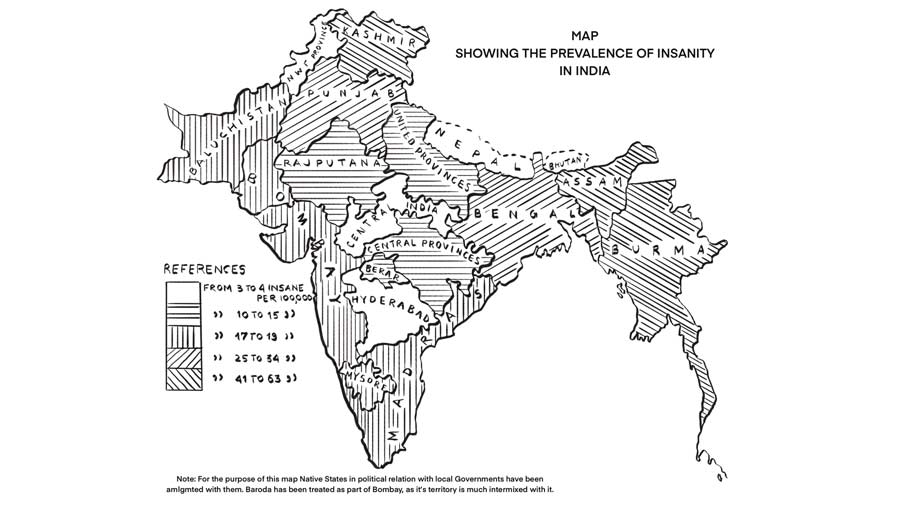Before there was awareness about mental health, any deviation from normal cognitive existence was usually attributed to ‘insanity’. A virtual exhibition by the Science Gallery Bengaluru, titled PSYCHE, has been curated as an exploration of mental health across India.
A project in this exhibit, titled The Asylum, delves into the history of mental health in several Indian cities, including Kolkata, especially pre-Independence Calcutta.
Created by Alok Sarin, Sanjeev Jain and Pratima Murthy (Alok and Sanjeev are also the authors of the book – The Psychological Impact of the Partition of India), The Asylum concludes that a kind of lunatic asylum existed in Kolkata before 1787. It states that the Calcutta Medical Board, in a letter dated May 7, 1787, recommended the foundation of a regular asylum to the government. This was approved on May 21, 1787, and assistant surgeon Willam Dick was appointed as the person-in-charge, for a monthly salary of Rs 200.
How psychiatric services began in India
“The Bengal asylum was the oldest in India, and consequently, has the most extensive records as it was the earliest presidency of the East India Company,” says Jain, adding that the objective of their work was to document how psychiatric services began in India. “For the first time in India’s history, the country was being spoken to by trained doctors in a service that was being run on scientific and administrative grounds.”

The Medical Board’s observation of European inmates at the Government Insane Hospital for Europeans in Calcutta stated, “The inmates of the Insane Hospital at this place are generally individuals taken from the lower classes of society, none of whom at any time enjoyed the luxuries and comforts usually possessed by better persons in the better ranks of life. To such individuals while under confinement all that is requisite by way of maintenance is that they should be treated with humanity and kindness due to their deplorable condition.”
Convict ship picking up ‘insanes’
In 1863 the Principal Inspector General of the Medical Department to the Secretary of the Government of Bengal made recommendations to transfer European patients back to Europe through the ship, Hougoumont. The reasons stated were the cost of housing and the lack of space in Indian asylums. They also believed that their return to their home country might improve their health. Jain adds that it was cheaper to treat patients there, than in Kolkata. Interestingly, the Hougoumont was a convict ship sailing from the UK to Australia which picked up ‘insanes’ on the way back.
The Asylum procured four documents describing specific cases of the patients, John Scott, Richard Stavers, Eliza Moirs and Henry Roose, who were recommended to be sent back to Europe. In one of the documents, Dr. Arthur Payne, superintendent of Insane Asylum, Bhowanipore, said that upon inspecting Hougoumont, he found that it could accommodate only 20 male and 10 female ‘insanes’, whereas the government had sanctioned the transportation of 22 males and 11 females.
According to the documents:
- 39-year-old John Scott was admitted to the asylum on August 23, 1862, when he showed symptoms of mania. His physical health had been failing. He was neglected by his wife, who placed him in the asylum, and his brother was unwilling to pay for his maintenance. He was recommended to be sent back to Europe as a pauper.
- Richard Stavers, a 23-year old pilot, was brought into the General Hospital on September 3, 1862. He seemed to have a case of hopeless dementia, slept little, would talk to himself, wanted to escape and had even threatened to kill himself. He was prescribed a change of climate from the Bhowanipore asylum.
- Eliza Moirs, 44 years old, was admitted to the asylum on October 6, 1860, but no change had been noticed in her condition till 1863, even turned violent towards one of the servants. Hence, her removal to Europe was strongly recommended.
- 39-year old Henry Roose, a wine merchant, was apprehended by the police for attempting to break into the Station Church. He made multiple attempts to escape from police custody. He claimed to have owned a hotel at Barrackpore, but had to give it up due to monetary issues, and then took a job as an assistant at a hotel at Chandernagore. He said that he was searching for his lost wife, but would invariably break down when questioned about her. His chances of recovering in India were deemed improbable.
Shift to Ranchi
“A new, larger asylum was built in Ranchi. Since mental healthcare was largely reserved for upper class white people, all asylums in the Bengal presidency were shut down in 1921, and the patients were sent to Ranchi. Hence, after the Partition, the entire region of East Pakistan was left without a single asylum. This shows how the care of the mentally ill was affected by colonialism,” said Jain.
Much of this information has been gathered from the British Library in London, the National Library of Scotland and the National Library of India in Kolkata.
You can explore The Asylum here. The PSYCHE exhibition can be viewed here.
